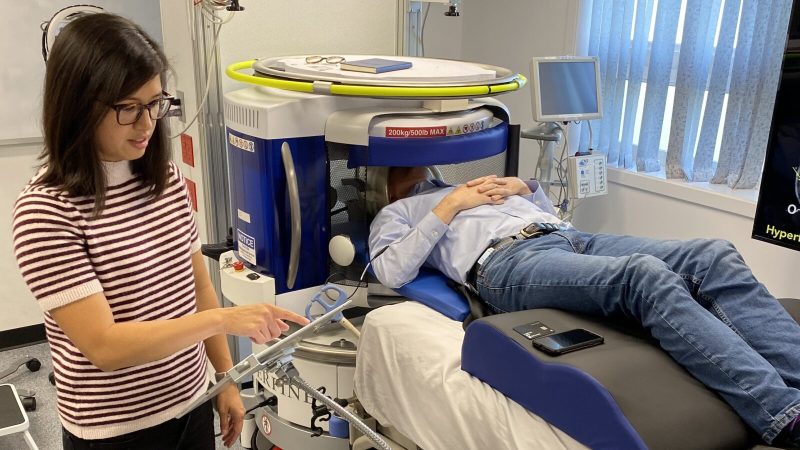TECH

Portable MRI Machine Comes To The Patient
To say that the process of installing a magnetic resonance imager in a hospital is a complex task is a serious understatement. Once the approval of regulators is obtained, a process that could take years, architects and engineers have to figure out where the massive machine can be installed. An MRI suite requires a sizable electrical service to be installed, reinforced floors to handle the massive weight of the magnet, and special shielding in the walls and ceiling. And once the millions have been spent and the whole thing is up and running, there are ongoing safety concerns when working around a gigantic magnet that can suck ferromagnetic objects into it at any time.
MRI studies can reveal details of diseases and injuries that no other imaging modality can match, which justifies the massive capital investments hospitals make to obtain them. But what if MRI scanners could be miniaturized? Is there something inherent in the technology that makes them so massive and so expensive that many institutions are priced out of the market? Or has technology advanced far enough that a truly portable MRI?
It turns out that yes, an inexpensive MRI scanner is not only possible, but can be made portable enough to wheel into a patient care room. It’s not without compromise, but such a device could make a huge impact on diagnostic medicine and extend MRI technologies into places far beyond the traditional hospital setting.
Align, Flip, Repeat
We’ve previously covered the basics of MRIs and why the machines are so loud. As a quick recap, recall that MRI scanners are essentially huge, powerful magnets that align the spin axes of all the protons in water molecules in the body tissues with the long axis of the body. Powerful radiofrequency pulses from antennas inside the bore of the machine perturb the spins, and sensitive receivers listen for the faint RF signals that result when the pulses end and the proton spin returns to the aligned states. Additional coils inside the bore, which are called gradient coils and make the characteristic noises of an MRI, shape the main magnetic field slightly and allow it to be rastered around the body, resulting in spatial data that, coupled with the RF signal, is turned into the detailed images we’ve all marveled at. The problem with miniaturizing an MRI scanner is that for these devices, size really does matter. The more powerful and even the magnetic field generated by the machine, the better the resolution of the instrument. The typical scanner in a hospital MRI suite has a magnet that operates at 1.5 Tesla, a field strength that requires superconducting coils cooled to nearly absolute zero with liquid helium. The magnet accounts for most of the bulk and weight of a large MRI scanner.
Permanent Magnets Work Too
Luckily, superconducting magnets are not strictly required for usable MRI scans. Clinically useful images can be obtained using any magnet that can create a strong, even field. Some large clinical machines still use permanent magnets or resistive electromagnets, but these have disadvantages. Permanent magnet scanners tend to have weaker fields and thus produce lower resolution images, while non-superconducting electromagnets have massive electrical needs and require constant cooling.
Still, permanent magnets are an attractive way to reduce the size of an MRI scanner, especially given advances of the last few decades in magnetics technology. The same rare earth elements that are being used to make the powerful magnets in everything from the brushless DC motors in drones to the powerplants of electric vehicles have found their way into permanent magnets powerful and compact enough that a bedside MRI scanner is possible.
Hyperfine Research, a company formed in 2014 by scientist and entrepreneur Jonathan Rothberg, recently won initial FDA approval for its Hyperfine point-of-care (POC) portable MRI system. Utilizing a permanent magnet of only 0.064 T, the scanner strips away everything not dedicated to the production of an image. There’s no patient handling system; rather, the machine is wheeled to a patient room, where the adjustable bed is used to position the patient. Power requirements are modest enough that the machine just plugs into a regular outlet. At 1,400 pounds (653 kg), it’s still a bulky beast, but it’s a far cry from the multiple ton behemoths that usually grace MRI suites.
Bring the Machine to the Patient
To be clear, Hyperfine is not marketing its POC machine as a replacement for standard MRI scanners. The POC scanner has a far lower resolution than a traditional MRI, and the images it produces would never take the place of those produced by a machine with a powerful superconducting magnet. And while Hyperfine’s marketing literature is quick to point out that the machine could bring MRI to underserved populations, like those in developing countries, chances are pretty good that the $50,000 price tag — peanuts compared to an MRI suite — will prove prohibitive.
The main niche that will likely be filled by this machine is revealed by the partner hospitals that are currently testing the scanner. Of the six hospitals, three have the machine in the neurology department, two are in the emergency department, and one is in pediatrics. The ability to quickly wheel the machine into a patient room and perform a survey MRI scan of the head will be invaluable to these specialties. ER and ICU patients, especially trauma patients, are often too sick to move to an MRI suite, so the ability to assess a traumatic brain injury or a stroke rapidly and without leaving the department could be critical to better outcomes.
by: Dan Maloney

No comments:
Post a Comment